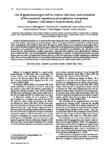Use este identificador para citar ou linkar para este item:
http://biblioteca.incaper.es.gov.br/digital/handle/item/346Registro completo de metadados
| Campo DC | Valor | Idioma |
|---|---|---|
| dc.contributor.author | MENEGUZZI, V. C. | pt_BR |
| dc.contributor.author | SANTOS, C. B. dos | pt_BR |
| dc.contributor.author | PINTO, I. de S. | pt_BR |
| dc.contributor.author | FEITOZA, L. R. | pt_BR |
| dc.contributor.author | FEITOZA, H. N. | pt_BR |
| dc.contributor.author | FALQUETO, A. | pt_BR |
| dc.contributor.other | Viviane Coutinho Meneguzzi, Universidade Federal do Espírito Santo; Claudiney Biral dos Santos, Ministério da Saúde; Israel de Souza Pinto, Instituto Oswaldo Cruz; Leandro Roberto Feitoza, Incaper; Hideko Nagatani Feitoza, Incaper; Aloísio Falqueto, Universidade Federal do Espírito Santo. | pt_BR |
| dc.date.accessioned | 2014-04-10T14:10:35Z | - |
| dc.date.available | 2014-04-10T14:10:35Z | - |
| dc.date.created | 2009 | pt_BR |
| dc.date.issued | 2014-04-10 | pt_BR |
| dc.identifier.issn | 1678-8060 | pt_BR |
| dc.identifier.other | 2858 | pt_BR |
| dc.identifier.uri | http://localhost:8080/digital/handle/item/346 | - |
| dc.identifier.uri | http://biblioteca.incaper.es.gov.br/digital/handle/item/346 | - |
| dc.description | In Brazil, introduced malaria occurs from the flat to the sloping hot areas, predominantly outside the Amazon Region, where endemic malaria has occurred in the past. This is a consequence of human migrations to other Brazilian states, including the state of Espírito Santo (ES). The objective of this study was to use geoprocessing to define the areas at risk of introduced malaria transmission and evaluate the vectorial importance of species of anophelines in ES. Anophelines were sampled from 1997-2005 in 297 rural localities identified or not identified as foci of malaria during the last 20 years. The geoclimatic variables temperature, relief and marine influence were obtained from a database of the ES Natural Units. The 14,663 anophelines captured belonged to 22 species. A significant association was found between the occurrence of malaria foci and the presence of hot, low-lying areas or gently undulating to undulating relief. The occurrence of the disease was associated with the presence of Anopheles darlingi and Anopheles aquasalis. Geoprocessing was determined to be a useful tool for defining areas at risk for malaria and vectors in ES. | pt_BR |
| dc.format | il. | pt_BR |
| dc.language | pt_BR | pt_BR |
| dc.publisher | Memórias do Instituto Oswaldo Cruz, Rio de Janeiro, v. 104 (4) : 570-575, jul. 2009. | pt_BR |
| dc.subject | Malaria | pt_BR |
| dc.subject | Anopheles | pt_BR |
| dc.subject | Geoclimatic variables | pt_BR |
| dc.subject | Espírito Santo | pt_BR |
| dc.subject | Brazil | pt_BR |
| dc.title | Use of geoprocessing to define malaria risk areas and evaluation of the vectorial importance of anopheline mosquitoes (Diptera : Culicidae) in Espírito Santo, Brazil. | pt_BR |
| dc.type | Artigo de periódico (quando a biblioteca tiver o título do periódico) | pt_BR |
| dc.ainfo.id | 2778 | pt_BR |
| dc.ainfo.lastupdate | 2014-04-10 | pt_BR |
| dc.ainfo.depositante | Merielem Frasson | pt_BR |
| dc.format.extent2 | 6 p. | pt_BR |
| Aparece nas coleções: | Memória Técnica do Incaper  | |
Arquivos associados a este item:
| Arquivo | Descrição | Tamanho | Formato | |
|---|---|---|---|---|
| 104-4-916.pdf | 670,65 kB | Adobe PDF |  Visualizar/Abrir |
Os itens no repositório estão protegidos por copyright, com todos os direitos reservados, salvo quando é indicado o contrário.
